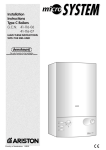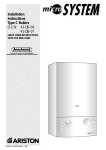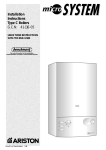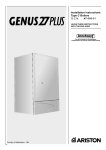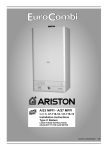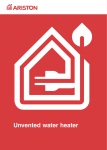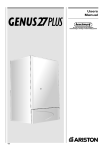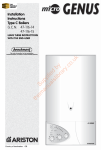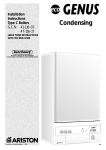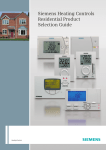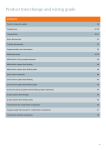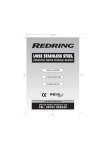Download Ariston microSYSTEM 15 RFFI Technical information
Transcript
Installation Instructions Type C Boilers G.C.N: 41-116-05 LEAVE THESE INSTRUCTIONS WITH THE END-USER Country of destination: GB TABLE OF CONTENTS 1. GENERAL INFORMATION 1.1 GENERAL INSTRUCTIONS 1.2 OVERALL VIEW 2. INSTALLATION 2.1 2.2 2.3 2.4 2.5 2.6 2.7 2.8 2.9 2.10 2.11 2.12 REFERENCE STANDARDS SITING THE APPLIANCE OVERALL DIMENSIONS CLEARANCES MOUNTING THE APPLIANCE ELECTRICAL CONNECTION GAS CONNECTION WATER CONNECTIONS FLUE CONNECTION ROOM THERMOSTAT CONNECTION ELECTRICAL DIAGRAMS GAS AND WATER CIRCUITS 3. D.H.W. STORAGE CYLINDER 3.1 2 PORT AND 3 PORT VALVE INSTALLATIONS 3.2 DOMESTIC HOT WATER PRIORITY KIT 4. COMMISSIONING 4.1 4.2 4.3 4.4 4.5 4.6 4.7 4.8 INITIAL PREPARATION CONTROL PANEL REMOVING THE FRONT PANEL INITIAL START UP OPERATIONAL ADJUSTMENTS COMBUSTION ANALYSIS FUME DISCHARGE MONITORING DRAINING THE SYSTEM 5. GAS ADJUSTMENTS GAS ADJUSTMENT TABLE 5.1 CHANGING THE TYPE OF GAS 1. GENERAL INFORMATION 6. MAINTENANCE 7. TECHNICAL INFORMATION This manual is an integral and essential part of the product. It should be kept with the appliance so that it can be consulted by the user and our authorised personnel. Please carefully read the instructions and notices about the unit contained in this manual, as they provide important infor mation regarding the safe installation, use and maintenance of the product. For operating instructions please consult the separate User’s Manual. 2 1.1 GENERAL INSTRUCTIONS Read the instructions and recommendations in these Installation Instructions carefully to ensure proper installation, use and maintenance of the appliance. Keep this manual in a safe place. You may need it for your own reference while our Servicing Centre technicians or your installer may need to consult it in the future. This is an appliance for the production of central heating (C.H.). This appliance must be used only for the purpose for which it is designed. The manufacturer declines all liability for damage caused by improper or negligent use. No asbestos or other hazardous materials have been used in the fabrication of this product. Before connecting the appliance, check that the information shown on the data plate and the table in section 7 comply with the electric, water and gas mains of the property. You will find the data plate on the reverse of the control panel. The gas with which this appliance operates is also shown on the label at the bottom of the boiler. Do not install this appliance in a damp environment or close to equipment which spray water or other liquids. Do not place objects on the appliance. Do not allow children or inexperienced persons to use the appliance without supervision. If you smell gas in the room, do not turn on light switches, use the telephone or any other object which might cause sparks. Open doors and windows immediately to ventilate the room. Shut the gas mains tap (at or adjacent to the gas meter) or the valve of the gas cylinder and call your Gas Supplier immediately. If you are going away for a long period of time, remember to shut the mains gas tap or the gas cylinder valve. Always disconnect the appliance either by unplugging it from the mains or turning off the mains switch before cleaning the appliance or carrying out maintenance. In the case of faults or failure, switch off the appliance and turn off the gas tap. Do not tamper with the appliance. For repairs, call your local Authorised Servicing Centre and request the use of original spare parts. For in-guarantee repairs contact MTS (GB) Limited. Check the following at least once a year: 1 - Check the seals for the water connections; replace any faulty seals. 2 - Check the gas seals; replace any faulty gas seals. 3 - Visual check of the entire unit. 4 - Visual check of the combustion process or analysis of combustion by-products (see section 4.5) and cleaning of the burner if needed. 5 - If called for by point. 3, dismantling and cleaning of the combustion chamber. 6 - If called for by point. 4, dismantling and cleaning of the burner jets. 7 - Visual check of the primary heat exchanger: - check for overheating in the blade assembly; - clean the exhaust fan if needed. 8 - Adjustment of the flow rate of the gas: flow rate for lighting, partial load and full load. 9 - Check of the heating safety systems: - safety device for maximum temperature (overheat thermostat); - safety device for maximum pressure (safety valve). 10- Check of the gas safety systems: - safety device for lack of gas or flame ionisation (detection electrode); - safety device for gas cock. 11- Check of the electrical connection (make sure it complies with the instructions in the manual). 12- General check of the combustion by-products of the discharge/ventilation system. 13- Check of the general performance of the unit. 3 1.2 OVERALL VIEW LEGEND: 1. 2. 3. 4. 5. 6. 7. 8. 9. 10. 11. 12. 13. 14. 15. 16. 17. 18. 19. 20. 21. 22. 23. 24. Flue connector Air intake for twin pipe flue systems Fan Combustion chamber hood Main heat exchanger Safety thermostat Combustion chamber Combustion chamber insulation panel Detection electrode Ignition electrodes Burner Regulation thermostat Frost thermostat Pump pressure switch Safety valve (3 bar) Automatic By-pass Gas valve Spark generator Boiler drain valve Circulation pump with automatic air release valve Expansion vessel Air pressure take-off point Air pressure switch Combustion analysis points 2. INSTALLATION The technical information and instructions provided herein below are intended for the installer so that the unit may be installed correctly and safely. 2.1 REFERENCE STANDARDS The installation and initial start up of the boiler must be by a CORGI Registered Installer in compliance with the installation standards currently in effect, as well as with any and all local health and safety standards i.e. CORGI . FIG. 1.0 This appliance must be installed by a competent installer in accordance with current Gas Safety (installation & use) Regulations. The installation of this appliance must be in accordance with the relevant requirements of the current Gas Safety (installation & use) Regulations, the Local Building Regulations, the current I.E.E. Wiring Regulations, the byelaws of the local water authority, and in Scotland, in accordance with the Building Standards (Scotland) Regulation and Health and Safety document No. 635 “Electricity at work regulations 1989”. Installation should also comply with the following British Standard Codes of Practice: BS 7593:1992 Treatment of water in domestic hot water central heating systems BS 5546:1990 Installation of hot water supplies for domestic purposes BS 5440-1:1990 Flues BS 5440-2:1989 Air supply BS 5449:1990 Forced circulation hot water systems BS 6789:1987 Installation of gas fired hot water boilers of rated input not exceeding 60kW BS 6891:1989 Installation of low pressure gas pipe up to 28mm BS 7671:1992 IEE wiring regulations BS 4814:1990 Specification for expansion vessels BS 5482:1994 Installation of LPG 4 2.2 SITING THE APPLIANCE The appliance may be installed in any room or indoor area, although particular attention is drawn to the requirements of the current I.E.E. Wiring Regulations, and in Scotland, the electrical provisions of the Building Regulations applicable in Scotland, with respect to the installation of the appliance in a room containing a bath or shower. Where a room-sealed appliance is installed in a room containing a bath or shower the appliance and any electrical switch or appliance control, utilising mains electricity should be situated so that it cannot be touched by a person using the bath or shower. The location must permit adequate space for servicing and air circulation around the appliance as indicated in paragraph 2.4. The location must permit the provision of an adequate flue and termination. For unusual locations special procedures may be necessary. BS 6798-1987 gives detailed guidance on this aspect. A compartment used to enclose the appliance must be designed specifically for this purpose. No specific ventilation requirements are needed for the installation within a cupboard. This appliance is not suitable for outdoor installation. The type C appliances (in which the combustion circuit, air vent intake and combustion chamber are air-tight with respect to the room in which the appliance is installed) can be installed in any type of room. Secondary ventilation is not required with this boiler. The boiler must be installed on a solid, permanent wall to prevent access from the rear. 400 mm 2.3 OVERALL DIMENSIONS LEGEND: 60 mm A C E mm = Central Heating Flow (3/4”) = Gas Inlet (3/4”) = Central Heating Return (3/4”) = Clearances 450 mm 2.4 CLEARANCES In order to allow for access to the interior of the boiler for maintenance pur poses, the boiler must be installed in compliance with the minimum clearances indicated in FIG. 2.1 132 C E 300 mm 132 FIG. 2.1 2.5 MOUNTING THE APPLIANCE Fasten the boiler in place using the template and anchors supplied with the unit. It is highly recommended that a spirit level be used to position the boiler so that it is perfectly level. For additional information, please consult the instructions contained in the connection kit and the flue kit. 2.6 ELECTRICAL CONNECTION For safety purposes, have a competent person carefully check the electrical system in the property, as the manufacturer will not be held liable for damage caused by the failure to earth the appliance properly or by anomalies in the supply of power. Make sure that the residential electrical system is adequate for the maximum power absorbed by the unit, which is indicated on the rating plate. In addition, check that the section of cabling is appropriate for the power absorbed by the boiler. 5 The boiler operates with alternating current, as indicated in the technical information table in section 7, where the maximum absorbed power is also indicated. Make sure that the connections for the neutral and live wires correspond to the indications in the diagram. The appliance electrical connections are situated on the reverse of the control panel under the inspection cover (see the ser vicing manual for fur ther information) FIG. 2.2 N L E IMPORTANT! In the event that the power supply cord must be changed, replace it with one with the same specifications. Make the connections to the terminal board located within the control panel, as follows: - The yellow-green wire should be connected to the terminal marked with the “ ” symbol; - The blue wire should be connected to the terminal marked “N”; - The brown wire should be connected to the terminal marked “L”. Note: The diagrams for the electrical system are indicated in section 2.12. Warning, this appliance must be earthed. External wiring to the appliance must be carried out by a competent person and be in accordance with the current I.E.E. Regulations and applicable local regulations. The microSYSTEM range of boilers are supplied for connection to a 230 V~ 50 Hz supply. The supply must be fused at 3 A. The method of connection to the electricity supply must facilitate complete electrical isolation of the appliance, by the use of a fused double pole isolator having a contact separation of at least 3 mm in all poles or alternatively, by means of a 3 A fused three pin plug and unswitched shuttered socket outlet both complying with BS 1363. The point of connection to the Electricity supply must be readily accessible and adjacent to the appliance unless the appliance is installed in a bathroom when this must be sited outside the bathroom (see section 2.2). 2.7 GAS CONNECTION 2.8 WATER CONNECTIONS The local gas region contractor connects the gas meter to the service pipe. If the gas supply for the boiler serves other appliances ensure that an adequate supply is available both to the boiler and the other appliances when they are in use at the same time. Pipe work must be of an adequate size. Pipes of a smaller size than the boiler inlet connection should not be used. VIEW OF THE BOILER CONNECTIONS FIG. 2.4 E D B A C A = Central Heating Flow C = Gas Inlet E = Central Heating Return F = Safety Valve G = Pump transportation screw (remove before igniting the boiler) H = Automatic By-pass pipe F FIG. 2.3 6 SC004A LEGEND: CENTRAL HEATING Detailed recommendations are given in BS 6798:1987 and BS 5449-1:1990, the following notes are given for general guidance. PIPE WORK: Copper tubing to BS EN 1057:1996 is recommended for water pipes. Jointing should be either with capillary soldered or compression fittings. Where possible pipes should have a gradient to ensure air is carried naturally to air release points and water flows naturally to drain taps. The appliance has a built-in automatic air release valve, however it should be ensured as far as possible that the appliance heat exchanger is not a natural collecting point for air. Except where providing useful heat, pipes should be insulated to prevent heat loss and avoid freezing. Particular attention should be paid to pipes passing through ventilated spaces in roofs and under floors. BY-PASS: The appliance includes an automatic by-pass valve, which protects the main heat exchanger in case of reduced or interrupted water circulation through the heating system, due to the closing of thermostatic valves or radiator valves within the system. SYSTEM DESIGN: This boiler is suitable only for sealed systems. Drain Cocks: These must be located in accessible positions to permit the draining of the whole system and should be fitted at all low points. The taps must be at least 15mm nominal size and manufactured in accordance with BS 2870:1980. SAFETY VALVE DISCHARGE: The discharge should terminate facing downward on the exterior of the building in a position where discharging (possibly boiling water & steam) will not create danger or nuisance, but in an easily visible position, and not cause damage to electrical components and wiring. The discharge must not be over an entrance or a window or any other type of public access. AIR RELEASE POINTS: These must be fitted at all high points where air naturally collects and must be sited to facilitate complete filling of the system. The appliance has an integral sealed expansion vessel to accommodate the increase of water volume when the system is heated. It can accept up to 6 litre (1.3 gal) of expansion water. If the heating circuit has an unusually high water content, calculate the total expansion and add an additional sealed expansion vessel with adequate capacity. This should be located on the return pipe work as close as possible to the pump inlet. MAINS WATER FEED - CENTRAL HEATING: There must be no direct connection to the mains water supply even through a non-return valve, without the approval of the Local Water Authority. FILLING: A temporary method for initially filling the system and replacing lost water during servicing and initial filling (in accordance with current Water Regulations), is provided as an integral part of the connection kit (see FIG. 2.4). The flexible hose must be removed once the system has been filled. RESIDUAL HEAD OF THE BOILER 7 2.9 FLUE SYSTEM The provision for satisfactory flue termination must be made in accordance with BS 5440-1. The appliance must be installed so that the flue terminal is exposed to outside air. The terminal must not discharge into another room or space such as an outhouse or lean-to. It is important that the position of the terminal allows a free passage of air across it at all times. The terminal should be located with due regard for the damage or discolouration that might occur on buildings in the vicinity. In cold or humid weather water vapour may condense on leaving the flue terminal. The effect of such “pluming” must be considered. If the terminal is less than 2 metres above a balcony, above ground or above a flat roof to which people have access, then a suitable terminal guard must be fitted. When ordering a terminal guard, quote the appliance model number. A suitable terminal guard is available from: TOWER FLUE COMPONENTS Morley Road Tonbridge Kent TN9 1RA The minimum acceptable spacing from the terminal to obstructions and ventilation openings are specified in FIG. 2.5. FLUE CONNECTIONS BC F G F D HI J A E L K G TERMINAL POSITION mm A - Directly below an openable window or other opening B - Below gutters, soil pipes or drain pipes C - Below eaves D - Below balconies or car-port roof E - From vertical drain pipes and soil pipes F - From internal or external corners G - Above ground or balcony level H - From a surface facing a terminal I - From a terminal facing a terminal J - From an opening in the car port (e.g. door, window) into dwelling K - Vertically from a terminal in the same wall L - Horizontally from a terminal in the same wall 300 75 200 200 75 300 300 600 1200 FIG. 2.5 The boiler is designed to be connected to a coaxial flue discharge system. Ø 60/100 mm FIG. 2.6 8 1200 1500 300 In addition, it is also possible to use a split (twin pipe) system by fitting a special adaptor to the flue connector and using the aperture for the air vent intake located on the top part of the combustion chamber. To utilise the air intake it is necessary to: 1. Remove the bottom of the air intake by cutting it with a suitable knife (see FIG. 2.7); 2. Insert the elbow into the air intake until it reaches the lower end. (There is no need to use gaskets or sealing compounds). FIG. 2.7 Ø 80 mm FIG. 2.8 IMPORTANT! COAXIAL SYSTEMS For all flue systems, a restrictor must always be inserted into the boiler’s flue connector; the restrictor must be Ø 41 in diameter depending on the length of piping indicated in TABLE 2.1. FIG 2.9 and FIG 2.10 illustrate some of the various designs for coaxial or twin pipe flue systems. For fur ther infor mation on discharge/ventilation accessories, see the FLUE PIPE ACCESSORIES MANUAL. FIG. 2.9 9 Exhaust Type Restrictor ø 41 mm C12 (xx) C32 (xx) C42 (xx) L min = 0.5 m L max = 1 m Exhaust Type Restrictor ø 41 mm C12 (xy) C32 (xy) C42 (xy) L max = 30 m 15 RFFI Coaxial Systems ø 60/100 15 RFFI Twin Pipe Systems ø 80/80 Risk of Condensation Forming Maximum Extension Piping not insulated Piping insulated Exhaust/Air ø 41 restrictor NO restrictor ø 41 restrictor NO restrictor L=5m NONE NONE NONE TABLE 2.1 NONE Maximum Risk of Condensation Forming Extension Piping not insulated Piping insulated Exhaust/Air ø 41 restrictor NO restrictor ø 41 restrictor NO restrictor 78 m 1.2 m 2.5 m 8m 11.0 m L = Sum of the total length of exhaust + air intake piping. FIG. 2.10 TWIN PIPE SYSTEMS In calculating the lengths of the pipes, the maximum length “L” must also take into consideration the values for the exhaust/air intake end terminals, as well as 90° elbows for coaxial systems. 2.10 ROOM THERMOSTAT CONNECTION A To connect a room thermostat and/or time clock, it is necessary to: 1. - Open the control panel as indicated in section 4.3; 2.- Remove screws “A” and remove the inspection cover from the reverse of the control panel; 3. - For the room-thermostat connect the thermostat switching wires to the position 5 and 6 and remove the wire link (for three-wire thermostats connect the neutral to terminal N); 4. - For the time clock connect the clock switching wires to the positions 3 and 4 and connect the clock motor electrical supply to the terminals marked L and N. Note: A frost thermostat is built-in to the appliance. For connection to control systems with zone valves for hot water cylinders see section 3. 10 2.11 ELECTRICAL DIAGRAM Legend: A B C D E F - On/Off Switch On/Off L.E.D. Heating Switch Heating L.E.D. Reset Button Ignition Failure (Lockout) L.E.D. A01 A02 A03 A04 A05 A06 A07 A08 A09 A10 A11 A12 A13 - Pump Pressure Switch Frost Thermostat Modulator Circulation Pump Regulation Thermostat External Control System Time Clock Connector External (Room) Thermostat Air Pressure Switch Fan Overheat Thermostat Spark Generator/Gas Valve Supply Detection Electrode Colours: Wh - White Bl - Blue Gry - Grey Brn - Brown Blk - Black Rd - Red Grn/Yll - Yellow/Green FIG. 2.12 11 FIG. 2.13 GAS AND WATER CIRCUITS 2.12 LEGEND: FIG. 2.14 17 1 2 16 3 4 5 6 7 8 9 15 10 14 13 11 12 12 1. 2. 3. 4. 5. 6. 7. 8. 9. 10. 11. 12. 13. 14. 15. Fan Main heat exchanger Overheat thermostat Burner Ignition electrodes Detection electrode Regulation thermostat Frost thermostat Gas valve Pump pressure switch Safety valve (3 bar) Boiler drain valve Automatic by-pass Pressure gauge Circulation pump with automatic air release valve 16. Expansion vessel 17. Air pressure switch A. Central Heating Flow B. Inlet Gas C. Central Heating Return 3. D.H.W. STORAGE CYLINDER 3.1 2 PORT AND 3 PORT VALVE INSTALLATIONS The microSYSTEM can be connected to a storage cylinder (both open-vented and unvented) for the production of domestic hot water (D.H.W.). Cylinders of different capacities can be used depending on site requirements (see TABLE 3.1 for a selection of ARISTON unvented cylinders). 2 port valve installation 3 port valve installation FIG. 3.1 FIG. 3.2 FIG. 3.3 Wiring to 2 port valve installation using an external 2 channel programmer Type Danfoss FP715 Type Honeywell ST6400C 13 Wiring to 3 port valve installation using an external 2 channel programmer Type Danfoss FP715 Type Honeywell ST6400C NOTE: FIG. 3.4 When using a 3 port valve installation in conjunction with an unvented cylinder it will be necessary to use a 2 port valve on the cylinder flow connection in addition to the 3- port valve to satisfy Building Regulations. TABLE 3.1 Technical Data C.H.W. Flow/rate m3/h D.H.W. Flow/rate It/h Max Heating Output kW Heat Ioss It. Coil Surface m2 Contract STI 125 Indirect 125 0.75 0.5 1 2 194 266 340 11.3 15.5 19.8 2 Comfort STI 125 Indirect Contract STI 150 Indirect 125 150 0.75 0.93 0.5 1 2 256 353 451 14.9 20.5 26.2 2.2 Comfort STI 150 Indirect Contract STI 210 indirect 150 200 0.93 0.93 0.5 1 2 256 353 451 14.9 20.5 26.2 2.4 Comfort STI 210 Indirect Contract STI 300 Indirect 200 300 0.93 0.93 0.5 1 2 256 353 451 14.9 20.5 26.2 2.9 SB 125 Indirect 125 1 0.5 1 2 190 318 496 11 18.5 28.8 1.72 SB 150 Indirect 150 1 0.5 1 2 190 318 496 11 18.5 28.8 1.75 SB 200 Indirect 200 1.3 0.5 1 2 190 318 496 11 18.5 28.8 2.1 MODEL Capacity 14 kWh/24h 3.2 DOMESTIC HOT WATER PRIORITY KIT Boiler microSYSTEM 15 RFFI The microSYSTEM is able to be connected to a specially designed kit for the management of D.H.W. production. This kit gives priority to production of D.H.W. unlike traditional systems where the boiler power is split between C.H. and D.H.W. This generally enables a smaller storage cylinder to be chosen as the boiler’s full output will be channelled into the cylinder allowing for a quick heat-up. Cylinder The kit (ARISTON part number 706329) can be obtained from an ARISTON supplier. Contract STI 125 Indirect The kit consits of: 1) Electronic module able to plug into the boiler’s P.C.B; 2) 3-way priority valve with actuator for connection to the boiler’s flow outlet; 3) A limit thermostat (80˚C) to check the water temperature of the heating flow to the cylinder, to be installed within the boiler; 4) Pipes and accessories. Comfort STI 125 Indirect Contract STI 150 Indirect Comfort STI 150 Indirect = Ideal TABLE 3.2 = Possible 4. COMMISSIONING 4.1 INITIAL PREPARATION MTS (GB) Limited support the initiative. Within the information pack you will find a copy of the logbook. It is important that this is completed in the presence of your customer, they are shown how to use it, and it is signed by them. Please instruct your customer that they must have their logbook with them whenever they contact a service engineer or us. Preliminary electrical system checks to ensure electrical safety must be carried out by a competent person i.e. polarity, earth continuity, resistance to earth and short circuit. FILLING THE HEATING SYSTEM: Remove the panels of the case and lower the control panel (see section 3.3 for further information). Open the central heating flow and return cocks supplied with the connection kit (there are two isolation points on the return connection). Unscrew the cap on the automatic air release valve one full turn and leave open permanently. Close all air release valves on the central heating system. Gradually open valve(s) at the filling point (filling-loop) connection to the central heating system until water is heard to flow, do not open fully. Open each air release tap starting with the lowest point and close it only when clear water, free of air, is visible. Purge the air from the pump by unscrewing anticlockwise and removing the pump plug and also manually rotate the pump shaft in the direction indicated by the pump label to ensure the pump is free. Refit the pump plug. Continue filling the system until at least 1.5 bar registers on the pressure gauge. Inspect the system for water leaks and remedy any leaks discovered. GAS SUPPLY: Inspect the entire installation including the gas meter, test for soundness and purge the supply as described in BS 6891:1988. Open the gas cock (supplied with the connection kit) to the appliance and check the gas connections on the appliance for leaks. When the installation and filling are completed turn on the central heating system (section 4.4) and run it until the temperature has reached the boiler operating temperature. The system must then be immediately flushed through. The flushing procedure must be in line with BS 7593:1992 code of practice for treatment of water in domestic hot water central heating systems. During this operation, we highly recommend the use of a central heating flushing detergent (Fernox Superfloc or equivalent), whose function is to dissolve any foreign matter that may be in the system. Substances different from these could create serious problems to the pump or other components. The use of an inhibitor in the system such as Fernox MB-1 or equivalent is strongly recommended to prevent corrosion (sludge) damaging the boiler and system. Failure to carry out this procedure may invalidate the appliance warranty. 15 4.2 CONTROL PANEL LEGEND: A B C D E F G H I J - On/Off button - On/Off L.E.D. green (frost protection active) - Central Heating button - Cental Heating active L.E.D. green - Ignition failure (lockout) and/or overheat reset button - Ignition failure (lockout) and/or overheat L.E.D. red - Central heating temperature adjustment - Energy Saving System (ESS) - Knock-out for time clock - Heating system pressure gauge 4.3 FIG. 4.1 REMOVING THE FRONT PANEL In order to access the inside of the boiler, it is necessary to unscrew the fastening screws “A” of the control panel located on the lower part of the panel itself. The control panel moves downward and when pulled forward rotates on two lateral hinges. The panel stays in a semi-horizontal position, which allows access to the inner parts of the boiler. In order to increase the manoeuvring space, it is possible to raise the control panel and rotate it to a fully horizontal position. To dismantle the front casing panel it is necessary to: 1 - Remove the two screws “B”; 2 - Move the front casing panel up and lift forward. 1 A 2 4 B 3 5 16 4.4 INITIAL START-UP 4.5 THE CHECKS TO BE RUN BEFORE INITIAL START-UP ARE AS FOLLOWS: 1. Make sure that: - the screw on the automatic air valve has been loosened when the system is full; - If the water pressure in the system is below 1.5 bar, bring it up to the appropriate level; - Ensure that the gas cock is closed; - Make sure that the electrical connection has been made properly and that the earth wire is connected to an efficient earthing system; - Supply power to the boiler by pushing the On/Off button “A” (see FIG.4.1) - the L.E.D. “B” will illuminate. Then push the button “C” in for central heating - the L.E.D. “D” will illuminate. This will start the circulation pump. After 7 seconds, the boiler will signal a shutdown due to ignition failure. Leave the boiler as it is until all of the air has been bled from the system. - Loosen the cap on the head of the pump to eliminate any air pockets; - Repeat the procedure for bleeding the radiators of air; - Check the system pressure and, if it has dropped, open the filling loop again to bring the pressure back up to 1.5 bar. 2. Make sure that all gate valves are open; 3. Turn on the gas cock and check the seals on the connections with an approved soap solution and eliminate any leaks. 4. Press the reset button “E” for the lighting system; the spark will light the main burner. If the burner does not light the first time, repeat the procedure. 5. Check the minimum and maximum pressure values for the gas going to the bur ner ; adjust it if needed using the values indicated in the table in section 5 (See the relative section for burner pressure adjustment within the servicing manual). COMBUSTION ANALYSIS The flue connector has two apertures, readings can be taken for the temperature of the combustion by-products and of the combustion air, as well as of the concentrations of O2 and CO2, FIG. 4.2 etc. . To access these intakes it is necessary to unscrew the front screw and remove the metal plate with sealing gasket. To achieve the best test conditions, turn the central heating adjustment knob “G” to the “max” position and remove the electrical connection to the heating sensor (see section 6.). This will allow the appliance to operate at the maximum heating power. 4.6 FUME DISCHARGE MONITORING In the boiler, it is possible to monitor the correct operation of the flue exhaust/air intake, checking for a loss of general pressure in the system. Through the use of a differential manometer connected to the test points of the combustion chamber, it is possible to detect the ∆P of operation of the air pressure switch. The value detected should not be less than 0.5 mbar under conditions of maximum thermal power in order for the boiler to function properly and without interruption. FIG. 4.3 17 4.7 BOILER SAFETY SYSTEMS The boiler is fitted with the following devices (see section 4.2 for references). 1 - IGNITION FAILURE: This indicates ignition failure when a flame is not detected within 7 seconds of starting an ignition sequence. The L.E.D. “F” will illuminate to signal the shutdown status. The system can be reset by pressing and releasing the button “E” after checking to make sure that the gas cock is open. 2 - INSUFFICIENT SYSTEM PRESSURE: In the event of insufficient water pressure in the heating system, a safety device will shutdown the boiler. Check the system pressure on the pressure gauge “J” and if it is less than 0.4 bar refill the system to 1.5 bar. Once the system pressure is at the correct level the boiler will ignite automatically. 3 - OVERHEATING: This control shuts off the boiler in the case where the primary circuit reaches a temperature in excess of 105°C. The red L.E.D. “F” will illuminate to signal this shutdown status. The system can be reset by waiting a few minutes for the primary exchanger to cool down and then by pressing and releasing the “E” button. 4. ANTI-FROST DEVICE: The boiler is equipped with a device that, in the event of the water temperature going below 6°C, the burner ignites at the minimum power until the boiler water reaches a temperature of 16°C. This device operates only if the boiler is functioning perfectly and: - the system pressure is sufficient; - the boiler is powered electrically - L.E.D. “B” illuminated; - the gas is turned on. 5 - EXHAUST DISCHARGE ANOMALY SHUTDOWN: The boiler is fitted with safety devices, which in the event of defective discharge of exhaust fumes, automatically interrupts the gas supply, thereby shutting off the boiler. The shutdown of the boiler is temporary and when the discharge state of exhaust fumes has returned to normal, the boiler automatically turns back on 4.8 DRAINING THE SYSTEM The heating system must be emptied as follows: - Turn off the boiler; - Attach a hose pipe and open the drain valve; - Empty the system at the lowest points (where present). When the heating system is unused for an extended period of time, it is recommended that you add antifreeze with an ethylene glycol base to the water in the heating lines and radiators if the ambient temperature drops below 0°C during the winter. This makes repeated draining of the entire system unnecessary. 18 5. GAS ADJUSTMENTS TABLE 5.1 Methane Gas G20 Liquid Butane Gas G30 Liquid Propane Gas G31 MJ/m3h mbar mbar 45.67 20 17 80.58 29 20 80.58 37 25 mm ø m3/h Kg/h 1.30 --1.62 ---- 0.77 3.3 ---1.21 0.77 3.3 ---1.19 mbar 8.5 22.1 28.8 CATEGORY II2H3+ Lower Wobbe Index (15°C;1013mbar) Nominal Delivery Pressure Minimum Delivery Pressure 15 RFFI Main Burner: n. 8 jets (ø) Restrictor Consumption (15°C; 1013mbar) Consumption (15°C; 1013mbar) Gas Burner Pressure: max - min [1 mbar = 10,197 mmc.a.] 5.1 CHANGING THE TYPE OF GAS VG002Ab FIG. 5.1 6. MAINTENANCE The outlet pressure of the gas cock is obtained by completely loosening the screw on the solenoid. The maximum pressure of the gas to the burner will be equal to the nominal delivery pressure minus the head loss within the gas valve. The boiler can be converted to use either methane (natural) gas (G20) or LPG (G30 - G31) by an Authorised Service Centre. The operations that must be performed are the following: 1. Replace the jets on the main burner (see table in section 5); 2. Pay attention to put the gas restrictor if convert the boiler from NG to GPL and to take it out when pass from LPG to NG; 2. Adjust the maximum and minimum thermal capacity values for the boiler (see table in section 5); 3. Replace the gas rating plate; 4. Adjust the maximum thermal power setting; 5. Adjust the soft-light feature (open the cover of the regulation screw on the gas valve (see F IG . 5.1). Rotate clockwise from min. to max. as per installation requirements). It is recommended that the following inspections be carried out on the boiler at least once a year: 1 - Check the seals for the water connections; replace any faulty seals. 2 - Check the gas seals; replace any faulty gas seals. 3 - Visual check of the entire unit. 4 - Visual check of the combustion process or analysis of combustion by-products (see section 4.5) and cleaning of the burner if needed. 5 - If called for by point. 3, dismantling and cleaning of the combustion chamber. 6 - If called for by point. 4, dismantling and cleaning of the burner jets. 7 - Visual check of the primary heat exchanger: - check for overheating in the blade assembly; - clean the exhaust fan if needed. 8 - Adjustment of the flow rate of the gas: flow rate for lighting, partial load and full load. 9 - Check of the heating safety systems: - safety device for maximum temperature (overheat thermostat); - safety device for maximum pressure (safety valve). 10- Check of the gas safety systems: - safety device for lack of gas or flame ionisation (detection electrode); - safety device for gas cock. 11- Check of the electrical connection (make sure it complies with the instructions in the manual). 12- General check of the combustion by-products of the discharge/ventilation system. 13- Check of the general performance of the unit. 19 6. TECHNICAL INFORMATION 15 RFFI CE Certification Heat Input Heat Output Efficiency of Nominal Heat Input Efficiency at 30% of Nominal Heat Input Heat Loss to the Casing (∆T=50°C) Flue Heat Loss with Burner Operating Flue Heat Loss with Burner Off Maximum Discharge of Fumes (G20) Residual Discharge Head Consumption at Nominal Capacity(G20) Gas Consumption after 10 Minutes* (15°C, 1013 mbar) (G30-G31) Temp. of exhaust fumes at nominal capacity CO2 Content max kW max kW % % % % % Kg/h mbar m3/h m3 Kg/h °C % O2 Content % CO Content Minimum Ambient Temperature Head Loss on Water Side (max) (∆T=20°C) Residual Head of System Heating Temperature Expansion Vessel Capacity Expansion Vessel Pre-load Pressure Maximum Water Content of System Maximum Heating Pressure Nominal Pressure Natural Gas (G20) LPG (G30-G31) Electrical Supply Power Consumption Protection Grade of Electrical System Internal Fuse Rating Weight ppm °C mbar bar max/min °C l bar l bar mbar mbar V/Hz W IP Kg G.C. Number 0063BL4994 15.4 14.1 82.4 81.8 1.6 6.5 0.2 32.7 0.3 1.63 0.17 1.21/1.19 122.3 6.5 8.5 19.2 +5 200 0.25 82/42 6 1 130 3 20 30-37 230/50 115 X4D FAST 2 AT 39 41-116-05 Commercial subsidiary: MTS (GB) LIMITED MTS Building Hughenden Avenue High Wycombe Bucks HP13 5FT Telephone: (01494) 755600 Fax: (01494) 459775 Internet: http://www.mtsgb.ltd.uk E-mail: [email protected] Technical Service Hot Line: (01494) 539579 Stampa: bieffe Merloni TermoSanitari SpA - Italy 23 99 84 1569 000 - Manufacturer: RECANATI *Calculated at 70% maximum output




















